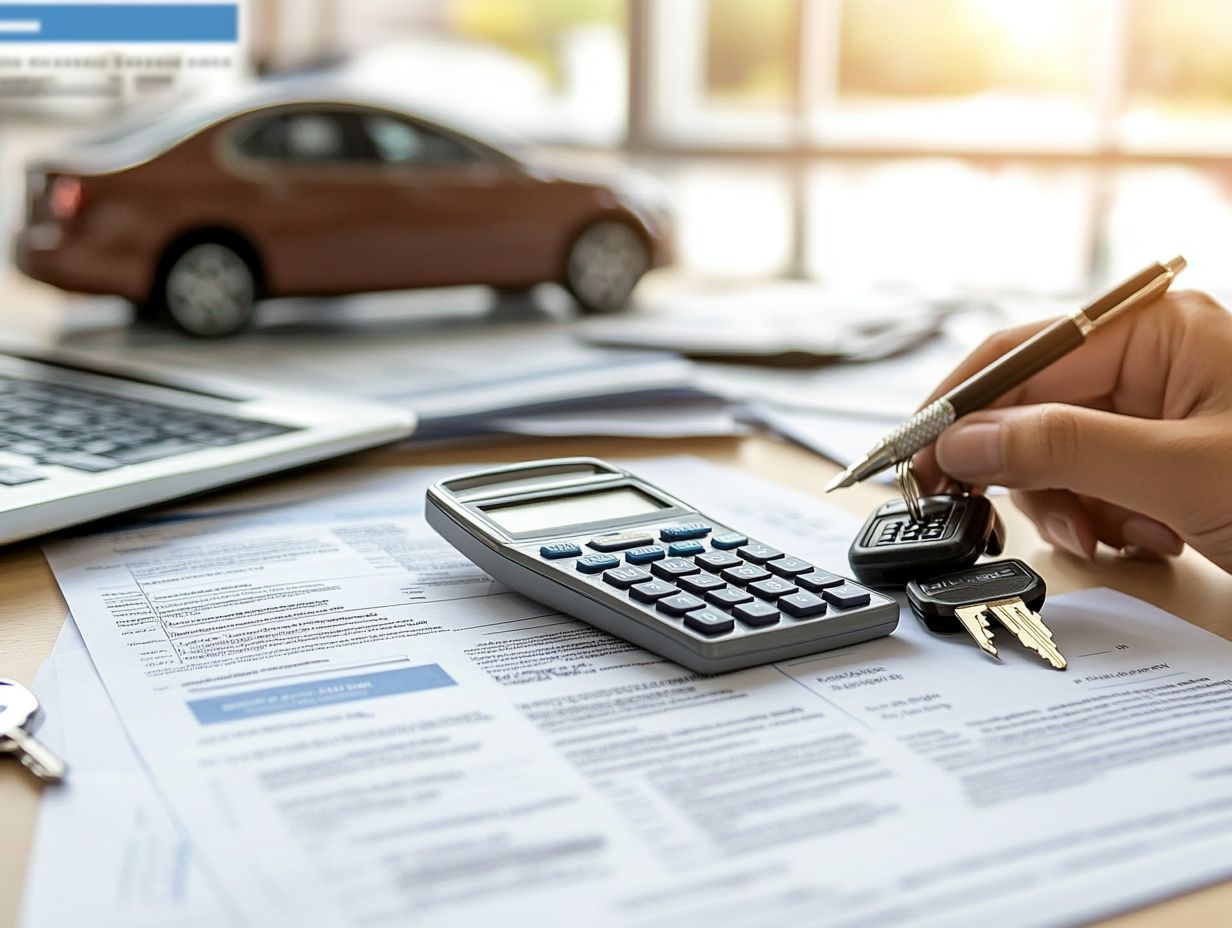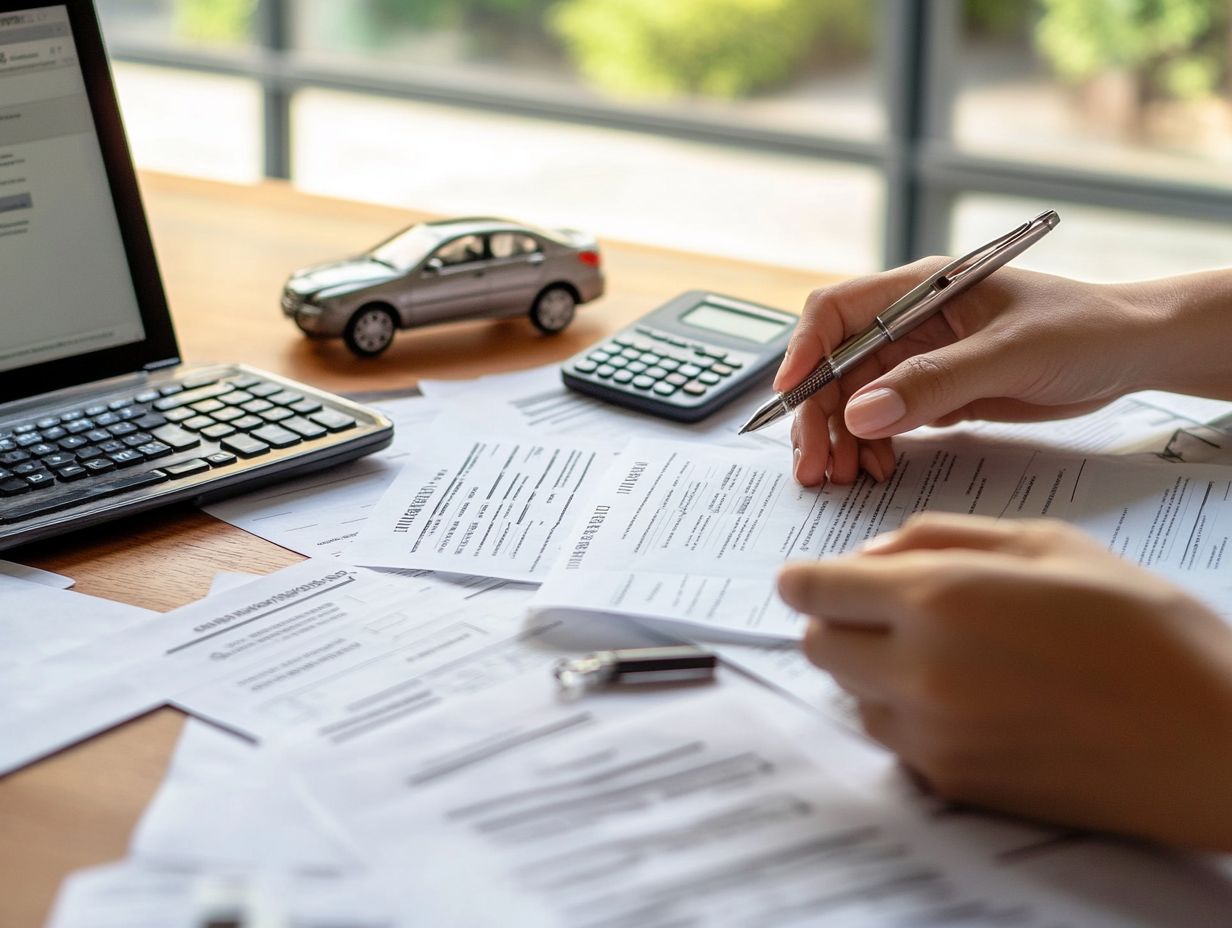What is Auto Insurance?
Auto insurance transcends mere legal obligation; it serves as a vital shield for your financial well-being and tranquility. This article delves into the essentials of auto insurance, clarifying its definition and purpose, the diverse types of coverage available, and the factors that influence your premiums.
You ll gain insights on how to choose the right policy tailored to your specific needs. Additionally, you will find savvy tips to save money on your insurance.
Whether you’re a novice driver or considering reassessing your current coverage, this guide is designed to equip you with the knowledge you need.
Contents
Key Takeaways:

- Auto insurance protects you financially in the event of car accidents, theft, and other damages.
- Coverage needs vary based on factors such as driving record, vehicle type, and location.
- Consider bundling policies and taking advantage of discounts to save on auto insurance costs.
Understanding Auto Insurance
Understanding auto insurance is essential for you as a vehicle owner, especially when it comes to safeguarding your financial assets against unpredictable incidents and liabilities. Auto insurance offers a range of coverage options designed to protect you from financial loss arising from accidents, property damage, and bodily injury.
This product not only gives you peace of mind but also keeps you compliant with state laws and insurance requirements. It s a crucial aspect of responsible vehicle ownership that you can t afford to overlook.
Definition and Purpose
Auto insurance serves as a contract between you and an insurance company, designed to provide financial protection against potential losses arising from auto incidents. This safety net is essential for any driver, as it helps cover costs related to accidents, theft, or damage to your vehicle.
The main goal of auto insurance is to alleviate the financial burden of unforeseen events, ensuring that your personal finances remain intact. You have access to various types of coverage, including:
- Personal injury protection, which covers medical expenses for you and your passengers.
- Uninsured motorist coverage, which offers protection if you’re injured by a driver without adequate insurance.
- Comprehensive coverage, which shields you against non-collision-related incidents, such as vandalism or natural disasters.
Knowing your coverage options is key to driving with confidence! Understanding these different types of coverage enables you to make informed decisions that ultimately bring you peace of mind while navigating the roads.
Types of Auto Insurance Coverage
There are several types of auto insurance coverage, each crafted to address specific needs and provide various forms of financial protection against accidents and damages.
Liability Coverage
Liability coverage is a cornerstone of auto insurance, designed to shield you from financial losses stemming from property damage and bodily injury inflicted on others during an accident. Think of this coverage as your safety net, ensuring you won t find yourself in dire straits following an unfortunate road incident.
Most states mandate this type of coverage, as it encourages responsible driving and guarantees that accident victims can secure compensation for their losses. Minimum coverage requirements can vary widely; for example, some states may require a minimum of 25/50/25 coverage.
This means $25,000 for bodily injury per person, $50,000 for total bodily injury per accident, and $25,000 for property damage. Other states might require higher limits to better protect everyone involved.
Having sufficient liability coverage not only meets legal requirements but also instills a reassuring sense of security while you re behind the wheel.
Conclusion
In summary, understanding auto insurance and its various types of coverage is vital. Make informed decisions to protect your financial well-being and drive with confidence!
Collision Coverage
Collision coverage is an optional type of auto insurance that can provide you with financial assistance for repairs to your vehicle after an accident, no matter who’s at fault.
This coverage typically comes with a deductible, which is the amount you pay from your own pocket before your insurance helps with the remaining repair costs. Common deductibles can range from $250 to $1,000, and opting for a higher deductible often leads to lower premiums.
It s especially beneficial in situations where you find yourself in a collision with another vehicle, an object, or even if your vehicle rolls over. Several factors can influence your overall insurance rates, such as your driving history, the make and model of your car, and local accident rates.
Consider these elements! They greatly affect your collision coverage.
By integrating this coverage into a comprehensive auto insurance policy, you not only bolster your financial protection but also gain peace of mind while navigating the roads.
Comprehensive Coverage

Comprehensive coverage protects you against vehicle damage that isn t related to collisions. It encompasses incidents such as theft, vandalism, and natural disasters.
This type of coverage is vital in protecting you from unexpected events, ensuring that you are financially protected from losses that can arise outside of typical accidents.
By opting for both types of coverage, you can enjoy a more favorable overall risk profile, which often leads to lower insurance premiums. This approach enhances your peace of mind and equips you to better navigate life’s unpredictabilities.
Factors that Affect Auto Insurance Rates
Numerous factors influence auto insurance rates, so it’s essential for you to grasp how your choices and circumstances can impact your insurance premiums.
Understanding these elements enables you to make informed decisions that can lead to better coverage options and potential savings.
Driving Record
A driver s record plays a pivotal role in shaping auto insurance rates. Maintaining a clean history often translates to lower premiums.
When assessing insurance costs, insurers meticulously examine your past behavior on the road, noting any accidents or traffic violations. A history dotted with incidents can result in increased rates, as insurers categorize these drivers as higher risk.
On the flip side, if your driving record is solid, you re likely to reap the rewards think discounts and more advantageous policy options. Should an accident arise, you might face higher out-of-pocket costs for reimbursement claims, particularly if your history reveals a pattern of negligence.
Over time, a poor driving record can quickly lead to serious financial strain!
Type of Vehicle
The type of vehicle you drive significantly influences your insurance rates. Certain models may incur higher maintenance costs or have a higher likelihood of being involved in accidents.
Insurance providers carefully evaluate the make and model when assessing risk factors. Vehicles equipped with advanced safety features, like automatic braking or lane assist, often enjoy lower premiums, reflecting their capacity to mitigate the risk of injury or damage during an accident.
On the flip side, models with subpar safety ratings can result in higher costs due to the increased risk they present. Cars known for high theft rates may come with limited coverage options and inflated premiums, as insurers factor in the likelihood of claims.
By understanding these dynamics, you can make informed choices when selecting your next vehicle. This ensures you get the best deal possible on your insurance.
Location
Your location has a significant impact on your auto insurance rates, as various states impose different insurance requirements and regulations that shape your coverage options.
For example, if you find yourself in an urban area, expect to pay higher premiums due to increased traffic congestion, elevated accident rates, and a higher likelihood of theft or vandalism. On the other hand, if you reside in a rural setting, you might enjoy more favorable rates due to less vehicle congestion and a decreased risk of collisions.
Understanding state laws is crucial; some jurisdictions require specific minimum coverage levels, which can lead to increased costs. These geographical differences also affect the types of policies available, ultimately influencing how you navigate your insurance choices and manage your overall expenses.
How to Choose the Right Auto Insurance Policy
Selecting the ideal auto insurance policy is crucial for securing comprehensive financial protection against potential losses and damages arising from accidents and unexpected events.
By making an informed choice, you safeguard not only your vehicle but also your peace of mind in the face of life s uncertainties.
Evaluating Coverage Needs

Evaluating your coverage needs is an essential step in selecting the right auto insurance policy, ensuring you have the financial protection necessary against various risks.
To effectively determine what you require, start by reflecting on your driving history. If you have a record of accidents or traffic violations, you may need higher liability limits. Next, consider the value of your vehicle; newer or more expensive cars often warrant full coverage that protects you in accidents and covers your car damage to shield you from hefty repair costs.
It s also prudent to think about potential expenses related to accidents, not just for damages but also for medical bills. Customizing your policy allows you to tailor coverage amounts that align with these factors.
By choosing products like gap insurance which covers the difference between what you owe and what your car is worth if it s totaled and roadside assistance, which helps you if your car breaks down, you can ensure comprehensive protection while keeping it within your budget.
Comparing Quotes
Comparing quotes from various insurance companies is key to finding the auto insurance policy that perfectly fits your budget and coverage needs.
To streamline this process, gather multiple quotes and take the time to evaluate each policy s terms, limits, and premiums. It’s essential to dive into the specifics of the coverage options available think liability, collision, and comprehensive coverage while also keeping an eye out for potential discounts that could significantly reduce your costs.
By understanding these factors, you can make informed decisions that not only satisfy your financial requirements but also provide robust protection for your vehicle. Ultimately, this thorough analysis enables you to choose a policy that aligns seamlessly with your unique circumstances.
Tips for Saving on Auto Insurance
Start saving on your auto insurance today with these smart strategies that enable you to reduce your premium payments without compromising on essential coverage.
Bundling Policies
Bundling policies streamlines your management of multiple policies and is an excellent strategy for saving on auto insurance, allowing you to combine your car insurance with other types of coverage for attractive discounts.
When you consider merging your auto insurance with home, health, or even renters insurance, you ll often find that many providers offer substantial incentives. By consolidating these policies, you can simplify your payment plans while effectively maximizing your coverage.
To make the most of these opportunities, it’s wise to reach out to insurance companies or agents to discuss potential bundled options. They can clarify the benefits and tailor packages to meet your specific needs, creating a truly advantageous situation for you.
Using Discounts
Using insurance discounts is a smart way to cut down your auto insurance costs while still having enough coverage.
Many insurance providers offer various discounts that can lower your premiums. For instance, safe driver discounts apply to those with clean driving records, while multi-policy discounts reward you for bundling your auto insurance with other coverages, like home or life insurance.
If you re a younger driver with a high GPA, you might qualify for good student discounts. Always ask about available discounts to maximize your savings!
Frequently Asked Questions
Here are some common questions about auto insurance answered:
What is Auto Insurance?

Auto insurance provides financial protection against damage or injury from car accidents. It can also cover theft, vandalism, and other damages not related to collisions.
What types of coverage are included in Auto Insurance?
Auto insurance typically includes liability, collision, and comprehensive coverage. Liability covers damages you cause to others, collision covers damage to your vehicle, and comprehensive covers non-collision damages.
Why is Auto Insurance important?
Auto insurance is crucial because it protects you financially in an accident. Without it, you d have to pay for damages and injuries out of pocket, which can be very expensive.
Do I need Auto Insurance?
Most states require auto insurance by law. Even if it s not mandatory, it s highly recommended to protect yourself and others on the road.
How is the cost of Auto Insurance determined?
The cost of auto insurance depends on several factors. These include your driving record, the type of car you drive, your age, gender, and the amount of coverage you select.
You can lower your premiums by maintaining a good driving record, choosing a vehicle with safety features, bundling your insurance policies, and increasing your deductibles. Don’t forget to ask your provider about any discounts they offer!






